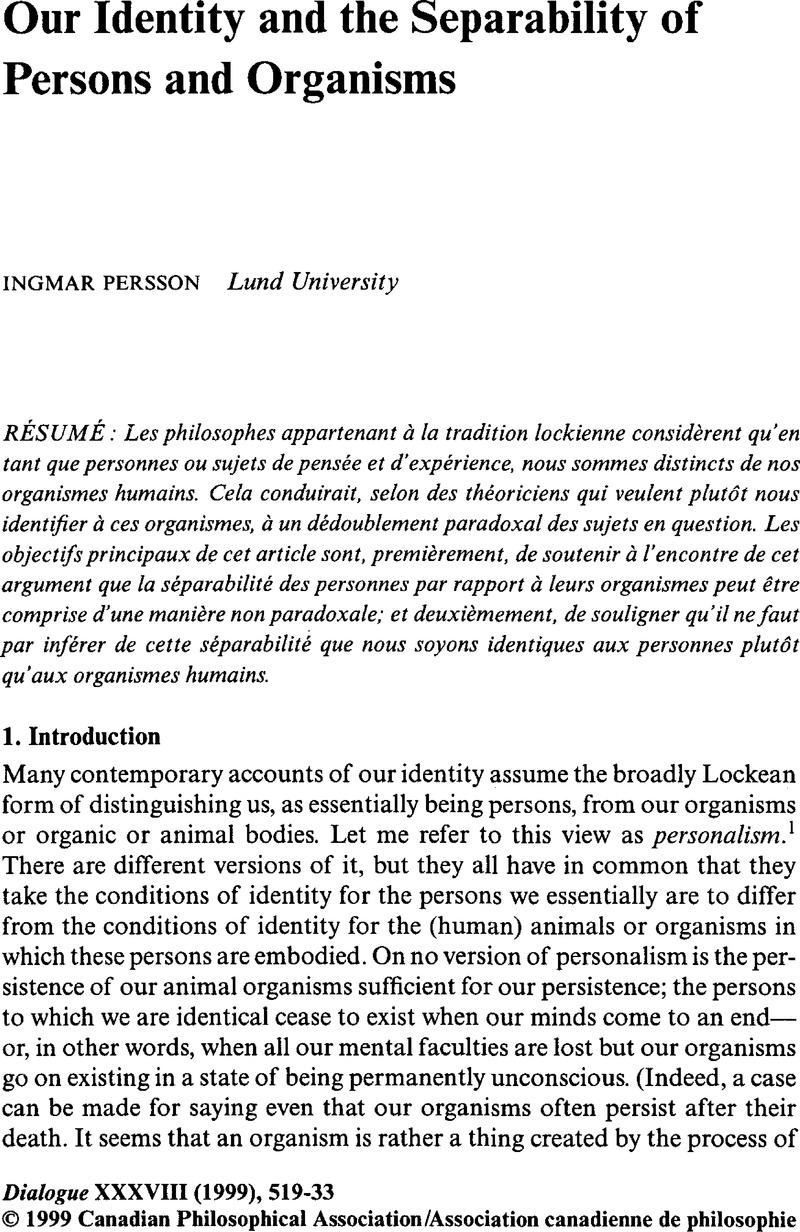Article contents
Our Identity and the Separability of Persons and Organisms
Published online by Cambridge University Press: 13 April 2010
Abstract

- Type
- Articles
- Information
- Dialogue: Canadian Philosophical Review / Revue canadienne de philosophie , Volume 38 , Issue 3 , Summer 1999 , pp. 519 - 534
- Copyright
- Copyright © Canadian Philosophical Association 1999
References
Notes
1 I here assume personalism to be a reductionist theory in Derek Parfit's sense, i.e., one that does not view persons as existing separately from their bodies and their psychological states; see his Reasons and Persons (Oxford: Clarendon Press, 1984), sec. 79.Google Scholar
2 See Ayers, Michael, Locke (London and New York: Routledge, 1991), vol. 2, chap. 19Google Scholar, and Feldman, Fred, Confrontations with the Reaper (New York and Oxford: Oxford University Press, 1992), chap. 6Google Scholar, but contrast Olson, Eric T., The Human Animal (New York and Oxford: Oxford University Press, 1997), pp. 136, 150–53.Google Scholar
3 Carter, William R., “How to Change Your Mind,” Canadian Journal of Philosophy, 19, 1 (March 1989): 1–16, especially pp. 9–11.CrossRefGoogle Scholar
4 Snowdon, Paul, “Persons, Animals, and Ourselves” in The Person and the Human Mind, edited by Gill, C. (Oxford: Oxford University Press, 1990), pp. 83–107, especially p. 91.Google Scholar
5 Ayers, , Locke, vol. 2, pp. 283–85.Google Scholar
6 Olson, , The Human Animal, pp. 106–109.Google Scholar
7 Since these writers–who, employing the term Snowdon coined in “Brain Transplants and Personal Identity” (in Human Beings, edited by Cockburn, D. [Cambridge: Cambridge University Press, 1991], pp. 109–26)CrossRefGoogle Scholar, will be labelled animalists–formulate their objections somewhat differently, I will not attempt any verbatim rendition. Rather, I will try to capture the quintessence of their objections.
8 This is a rather short step for personalists who are reductionists in Parfit's sense, but it is not entailed by this reductionism.
9 Interestingly, Carter slips into conceding the existence of two subjects of thought and experience. Discussing a case in which the mind/brain of a human organism who has climbed Mt. Everest is transferred to another organism, he writes that, after this transfer, this “mind remembers being part of an individual who climbed Everest” (Carter, “How to Change Your Mind,” p. 13). Here it is granted both that a mind performs mental operations such as remembering and that it is part of a human individual or organism. Since Carter insists that the latter is also the subject of mental predication, he is committed to there being two such subjects.
10 The notion of a predicate being derivatively applicable to a particular subject must not be confused with that of a predicate being derivative–i.e., with that of a predicate whose applicability to something is always a logical consequence of another predicate being applicable to the same thing, as, e.g., the applicability of the predicate “has some weight (or other)” to something is always a logical consequence of the applicability of some specific weight predicate to this thing (and the latter applicability is not derivative, since the fact that this thing has this weight is not a logical consequence of something distinct from it having this particular weight). Here it is the predicate which is derivative rather than particular applications of it.
11 This proposal is also immune to what seems (but only prima facie, I think) to be a difficulty for the idea that persons and their organisms have all matter in common; what is it, then, that gives them different persistence conditions? This objection is pressed by Olson, The Human Animal, pp. 97-102.
12 To simplify this discussion, I am prepared to concede the controversial claim that an organism exists only as long it is alive (see note 2).
13 Thus, there is a tension between Olson's claim in The Human Animal that each of us “comes into being about sixteen days after fertilization” (p. 91) and his claim that “your brainstem, as the organ that is chiefly responsible for directing your life-sustaining functions, is essential to you” (p. 140).
14 Hence, Peter van Inwagen cannot be correct in arguing that (a) there is a unitary thing that elementary particles compose if and only if their activity con stitutes a life, and that (b) if there is thinking and feeling “there must be a thing, one thing, that is doing the thinking and feeling” (Inwagen, Peter van, Material Beings [Ithaca and London: Cornell University Press, 1990], section 9; p. 12Google Scholar; see also sec. 12). It is (a) that we should be suspicious of. For further discussion, see my “Critical Study” of van Inwagen's book in Noûs, 27, 4 (December 1993): 512–18.Google Scholar
15 The philosophical discussion of this issue was sparked off by Nagel's, Thomas paper, “Brain Bisection and the Unity of Consciousness,” reprinted in his Mortal Questions (Cambridge: Cambridge University Press, 1979). It is also discussed by, among others, Parfit in Reasons and Persons, chap. 12.Google Scholar
16 For further elaboration of these reflections, see Olson, The Human Animal.
17 I argue for the circularity of a psychological criterion that appeals to experiential memory in “The Involvement of Our Identity in Experiential Memory,” Canadian Journal of Philosophy, 27, 4 (December 1997): 447–65.CrossRefGoogle Scholar
18 Strictly speaking, the proto-animalist and proto-personalist strands of our thinking, for the philosophical positions of animalism and personalism seem to be refinements of these strands. As noted, personalism is not just the view that we are the primary owners of our minds, but that we are something essentially mental. And, under the pressure of the science of biology, I think animalists may have to work out the persistence conditions for animals of the human species in a way that is discordant with the everyday practice of reidentification.
19 I am grateful to Eric T. Olson, Derek Parfit, and Paul Snowdon for valuable comments on earlier drafts of this paper.
- 11
- Cited by


